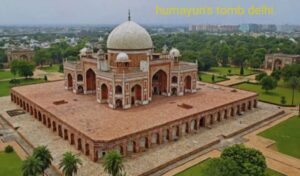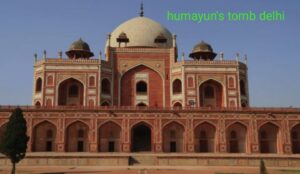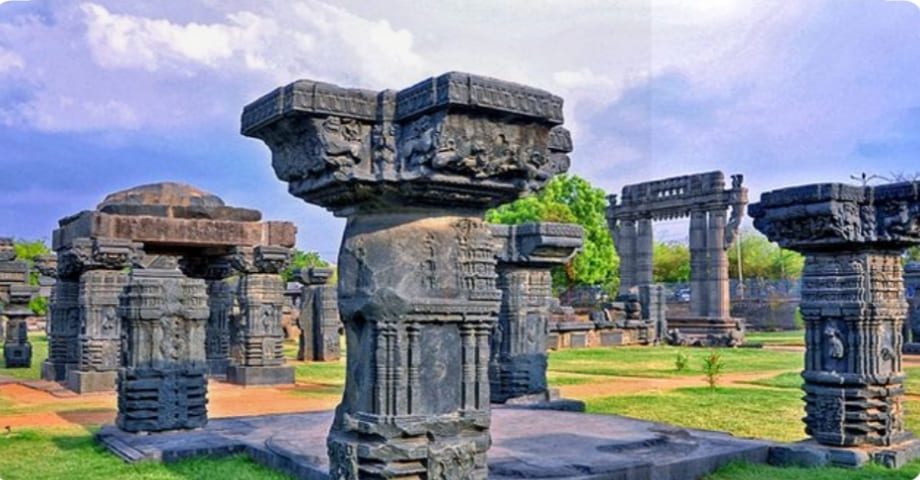Nestled in the heart of Delhi, Humayun’s Tomb Delhi stands as a testament to the grandeur of Mughal architecture and the rich tapestry of Indian history. This magnificent mausoleum, often regarded as the precursor to the Taj Mahal, holds immense historical and cultural significance. Designated as a UNESCO World Heritage site, it attracts countless visitors each year who come to marvel at its architectural brilliance and serene beauty.

1. Humayun’s Tomb, Delhi : Historical Background
Humayun, the second emperor of the Mughal dynasty, is the namesake of this splendid tomb. After his untimely death in 1556, his wife, Empress Bega Begum, commissioned the construction of a grand mausoleum to honor his memory. The project began in 1565 and was completed in 1572, under the meticulous supervision of Persian architect Mirak Mirza Ghiyas. The tomb not only serves as Humayun’s final resting place but also symbolizes the enduring love and devotion of his wife.
2. Humayun’s Tomb, Delhi: Architectural Marvel
Humayun’s Tomb is a remarkable blend of Persian and Mughal architectural styles. The structure’s design is characterized by its large-scale use of red sandstone, contrasted with white marble inlays. The mausoleum itself is set on a raised platform and crowned with a double dome, which became a defining feature of later Mughal architecture. The intricate lattice work, geometric patterns, and arched alcoves add to the monument’s aesthetic appeal. This architectural masterpiece influenced the design of subsequent Mughal structures, including the world-renowned Taj Mahal.

3.Humayun’s Tomb, Delhi: Significance of Charbagh
One of the most striking features of Humayun’s Tomb is its Charbagh garden, a quintessential element of Persian garden design. The Charbagh, which translates to “four gardens,” is divided into quadrants by walkways and water channels, symbolizing the Islamic paradise. This layout not only enhances the visual appeal of the site but also represents the Mughal concept of an earthly paradise. The influence of the Charbagh design is evident in many later Mughal gardens, including the one surrounding the Taj Mahal.
4. Restoration and Preservation
Over the centuries, Humayun’s Tomb has witnessed significant wear and tear. However, extensive restoration efforts by the Archaeological Survey of India (ASI) and the Aga Khan Trust for Culture (AKTC) have helped preserve its splendor. Major restoration projects have focused on structural repairs, garden rejuvenation, and the revival of traditional building techniques. These efforts have not only restored the tomb’s former glory but also ensured its preservation for future generations.
5. Visitor Experience
Located near the bustling Nizamuddin area, Humayun’s Tomb is easily accessible by road and public transport. The best time to visit is during the cooler months, from October to March, when the weather is pleasant. The site is open from sunrise to sunset, with a nominal entry fee for both domestic and international tourists. Visitors can also explore nearby attractions, such as Isa Khan’s Tomb and the Nizamuddin Dargah, to enrich their cultural experience.
6. Photography Tips
Humayun’s Tomb offers numerous opportunities for stunning photography. The best times to capture its beauty are during the early morning and late afternoon golden hours when the soft light accentuates the architectural details. For an impressive shot, position yourself at the main entrance to capture the symmetry of the Charbagh and the grandeur of the tomb. Bringing a wide-angle lens can help capture the monument’s scale and the surrounding gardens.
7.Interesting Facts and Legends
Humayun’s Tomb is steeped in fascinating stories and legends. It is said that Empress Bega Begum dedicated her life to overseeing the construction of the tomb, ensuring that no expense was spared. Another intriguing fact is that the tomb complex houses over 150 graves of Mughal royalty, making it one of the most extensive dynastic tombs in the world. Additionally, the design of Humayun’s Tomb is believed to have inspired the construction of the Taj Mahal, one of the most iconic structures in the world.
Conclusion:
Humayun’s Tomb is more than just a historical monument; it is a symbol of love, architectural ingenuity, and cultural heritage. Its grand design and serene gardens offer a glimpse into the opulent world of the Mughals. Visiting this UNESCO World Heritage site is a journey through history, providing a deeper understanding of India’s rich past. Whether you’re a history buff, an architecture enthusiast, or a casual traveler, Humayun’s Tomb is a must-visit destination that promises to leave you in awe.
FAQ:
1.What is the story of Humayun’s tomb Delhi?
2.On which day is Humayun Tomb closed?
3.What is the ticket price of Humayun’s tomb?
4.Who is buried under Humayun Tomb?
5.humayun’s tomb, built by
6.Humayun’s tomb delhi history
7.10 Lines on Humayun Tomb
8.Humayun tomb built by his wife
9.Humayun’s tomb delhi timings
10.Humayun’s tomb delhi price

